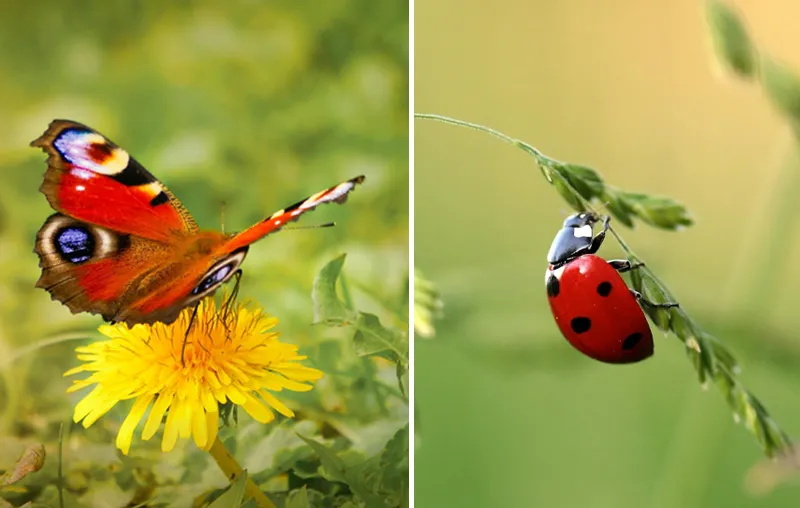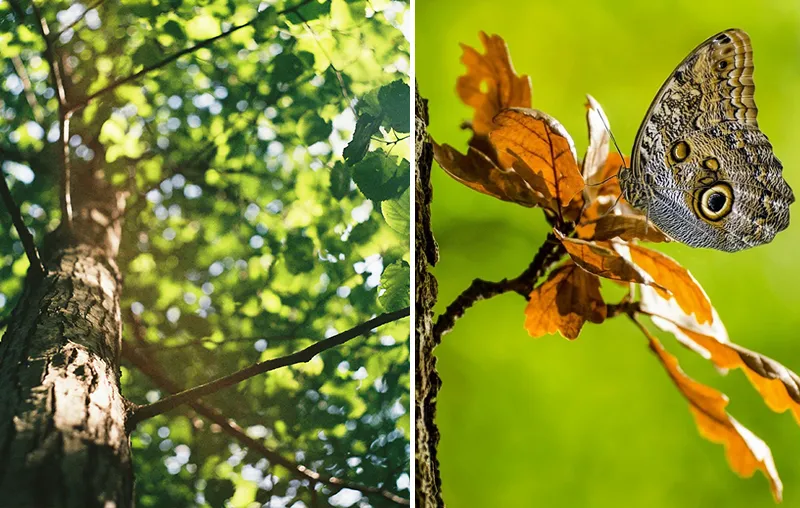Do you want to create an insect-friendly garden and help the little garden dwellers? Then you've come to the right place! Whether butterflies, ants, bees, bumblebees, caterpillars, dragonflies, fireflies or ladybugs: the world of insects is so incredibly huge and diverse. In Germany alone, there are over 33,000 different speciesall of which fulfill an important ecological function.
However, the majority of them are already highly endangered today. Among other things, sealed soils, low-maintenance gravel gardens, more and more artificial light sources and industrial agriculture are leaving their mark. Fortunately, you can make a real difference for insects and the environment at home. biodiversity make
In this article, I'll show you the best tips for transforming your garden into a natural paradise for insects. Let's go!
Reasons: Why should you create an insect-friendly garden?
Before we move on to the specific measures, I would like to take this opportunity to give you a brief overview. Extra boost of motivation to the hand. In my opinion, the following are some of the advantages of designing a garden for insects:
- Securing biodiversity: You create habitats for numerous notch animals and counteract the global extinction of insects. Over 40 percent of the world's insects are threatened with extinction.1
- Fighting pests naturally: Many insects eat so-called pests (e.g. ladybugs are predators of aphids) and help you to keep your plants in the garden healthy.
- Promote pollinators: You support wild bees and other insects that are important for the Pollination of wild and crop plants are crucial and ensure our food security.
- Improve soil health: Insects contribute to the aeration and fertility of the soil. They therefore guarantee better plant growth and higher crop yields.
- Enjoy a beautiful garden: You can relax in your hammock and enjoy the colorful, blooming plants and the buzzing and humming of the insects in your garden.
- Protect the environment: In an insect-friendly garden, you create valuable habitats for insects that stabilize ecosystems and also benefit the environment. climate change counteract.
- Be a role model: You prove that aesthetic, low-maintenance and at the same time insect-friendly gardening is absolutely possible - and set a positive example.
11 tips: How can anyone create an insect-friendly garden?
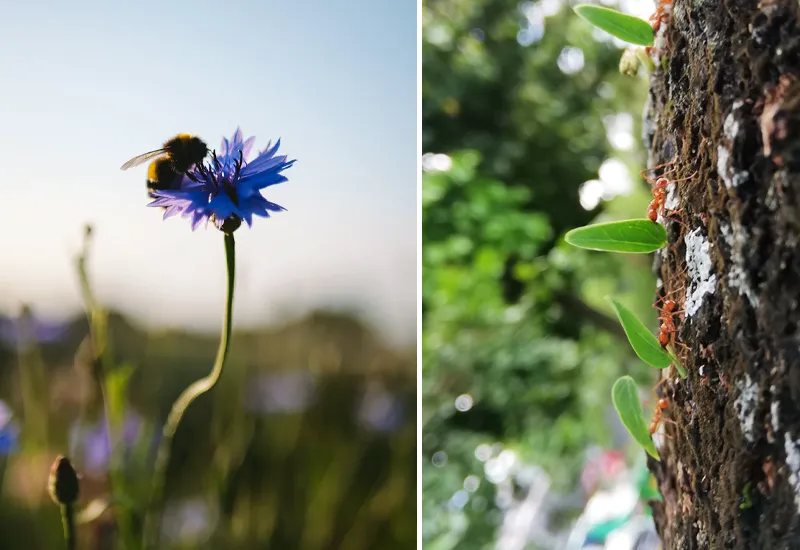
Motivated enough? 🙂 Then use the following tips for an insect-friendly garden. You'll soon realize that it fairly simple and also absolutely not expensive is to support the small garden animals too.
1. select native, insect-friendly plants
If you want to promote insect diversity, your garden should be rich in insect-friendly treeswild shrubs, perennials and wildflowers that grow in our local nature, that animals can Food and protection and bloom throughout the year.
Butterflies, wild bees, caterpillars, beetles and other insects are adjusted to these plants. The latter are also more resistant to climatic changes and diseases.
Here I have you Important insect magnets from the plant world that should not be missing in your garden:
Trees:
- Willows (e.g. sal willow (Salix caprea) or fragile willow (Salix fragilis))
- German oak (Quercus robur)
- Large-Leaved Lime (Tilia platyphyllos)
Shrubs:
- Common Hawthorn (Crataegus monogyna)
- Wine rose (Rosa rubiginosa)
- Sloe (Prunus spinosa)
Perennials and flowers:
- Cornflower (Centaurea cyanus)
- Nodding cinquefoil (Silene nutans)
- Meadow Sage (Salvia pratensis)
Important: Do not use Invasive neophytes. Lilac or cherry laurel, for example, have been introduced and are spreading rapidly and displacing native plant species.
2. create hiding places
Insects must protect themselves from predators Hide and protect can. They are also looking for suitable Nesting sites.
That's why an insect-friendly garden always has Deadwood pile, Cairn, Dry stone walls, a Beetle cellar or a Benjes hedge.
Integrate these different structures so consciously include them in your garden planning - or ensure afterwards that they are available to insects.
3. plant a wild shrub hedge
Many garden owners opt for privacy fences made of metal, plastic or wood. How about simply planting a hedge of native wild shrubs instead? This is also a good privacy screen, blooms beautifully, often offers delicious berries and is a ideal habitat for bees, caterpillars, butterflies, beetles and birds.
I have already recommended hawthorn, dog rose and blackthorn. Here are a few more other, insect-friendly, native shrubs or small trees that are ideal for a wild hedge:
- Rock pear (Amelanchier ovalis)
- Pike rose (Rosa glauca)
- Eared willow (Salix aurita)
- Yellow bladder bush (Colutea arborescens)
Speaking of birds! How you can change your Make your garden bird-friendlyyou can find out in a separate article on the blog. So take a look there too!
4. create wild corners and a wildflower meadow
In nature, nothing is straight and tidy - Nature is wild! And that's exactly why you should leave some dead wood here and there and let dandelions grow. Because this creates new habitat.
I also like to consciously place a Wild corner with wildflowers in the garden on, relax, lean back and Let nature do its thing. This is another reason why Natural gardens are so easy to maintain!
5. avoid pesticides and chemical fertilizers
Harmful pesticides, such as insecticides, kill insects and massively disrupt the ecological balance in the garden. It goes without saying that such chemical pesticides have no place in a Natural garden for insects! Just as little as chemical fertilizers.
Instead, promote beneficial insects and rely on the natural pest controland organic fertilizers. The latter include, for example Compost and plant manure.
6. set up water points
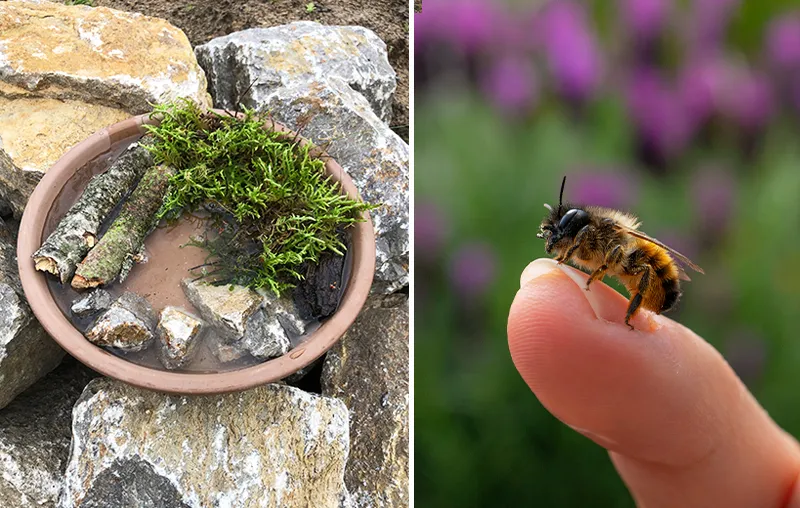
Insects need water! Especially in hot, dry phases of the year the liquid from the ingested nectar is no longer sufficient.
With a self-built Bee drinker you can provide them with a helpful source of water - both in the garden and on the balcony. Flower pot coasters are particularly suitable for this. Simply place a few Stones, wood and some moss so that wild bees, butterflies and other insects can reach the water safely.
7. create a compost heap
With a self-created compost heap you make valuable vegetable and garden waste, fertile soil. However, the decomposition work is done by the animal world!
In addition to worms, woodlice, mites, centipedes and spiders, a compost heap is also the habitat of numerous insects! For example for Ants, flies, caterpillars, dung beetles or the popular Rhinoceros beetle. Many insects lay their larvae there, which is why it is an important part of an insect-friendly garden.
8. mow the lawn less often and leave areas unmown
Why does a lawn always have to be perfectly cut and mowed weekly? If you simply leave the lawnmower in the garage, the insect world in particular will benefit from the growing flowering plants (e.g. daisies, dandelions and white clover), which can finally unfold.
Also the longer grass protects the lawn from drying out - and you have Less stress when gardening. A few good reasons to give up mowing the lawn and, for example, to use a lawn mower the next time you mowing-free May to join in. Alternatively, you can simply leave a few areas of the lawn unmown.
9. create nesting aids
Those who are environmentally conscious and sustainable gardeningalso promotes nesting opportunities for insects. Because precisely these are often rare these days.
The Compost heap I have already mentioned. But even with a self-created Sandarium you can do many wild bee species and other earth-nesting insects a big favor.
In the same way, a Insect hotel can be useful. But avoid the usually incorrectly constructed products from DIY stores and garden centers - and build it yourself instead!
10. prefer minimalist garden lighting
Man-made, artificial light sources, such as outdoor lights in gardens or street lamps, are on the increase. And Flying insects use this as a guide.
As a result, in one night alone, an average of one lantern about 150 insects burn up or perish exhausted.
So in an insect-friendly garden, we should all try to Light pollution from the house or directly in the garden to a minimum. This works, for example, with Timers, motion detectors or light sources directed downwards - preferably without blue components in the light.
11. create a garden pond
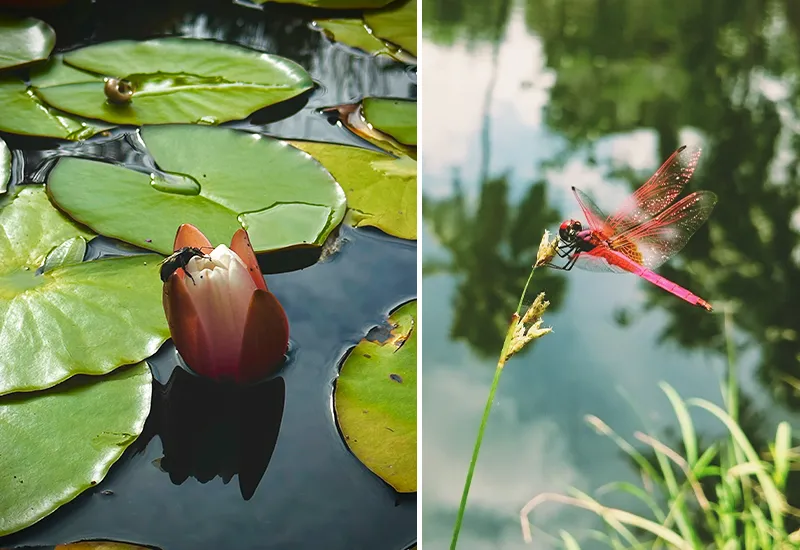
We've already talked about water. If you have a little more space in your garden, you can also create a real insect-rich biotope with a near-natural garden pond as a supplement or alternative to a bee watering trough. An oasis like this is especially appreciated by Dragonflies, bees, butterflies, pond beetles and mosquito larvae.
Make sure that the insects are above Shallow shore zonesstones and plants always have easy access to the water.
Here I have also put together a few Insect-friendly pond plants picked out:
- Water mint (Mentha aquatica)
- Marsh marigold (Caltha palustris)
- Purple loosestrife (Lythrum salicaria)
- Meadowsweet (Filipendula ulmaria)
Insect-friendly garden, made easy!
It has become a fascinating and fulfilling hobby for me to consciously make my garden insect-friendly. I learn something new every day - and can more and more the humming and buzzing of wild bees, butterflies, beetles and dragonflies.
Here and now you have learned the most important measures for this! From native plants and unmown lawns to sandaria and deadwood piles. Use the tips and tricks to create a noticeable difference for the protection of insects.
"Any foolish boy can stamp on a beetle, but all the professors in the world cannot make a beetle."
Arthur Schopenhauer (more at Garden Quotes)
I hope that this article will inspire you to transform your garden into a species-rich paradise. Do you have any questions, suggestions or further tips? Then I look forward to your comment!
Stay close to nature and environmentally conscious,

PS: More and more people are even eating insects! In the next article, I'll be happy to explain why I think that we humans should not eat insects.
Source reference:
- WWF Germany: The silent death of insects (as of 01.07.2022), available at https://www.wwf.de/themen-projekte/artensterben/insektensterben. [15.07.2024]. ↩︎

